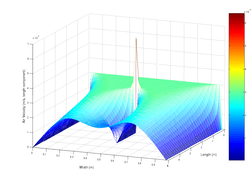파일:Navier Stokes Laminar.svg

SVG 파일의 PNG 형식의 미리보기 크기: 750 × 600 픽셀. 다른 해상도: 300 × 240 픽셀 | 600 × 480 픽셀 | 960 × 768 픽셀 | 1,280 × 1,024 픽셀 | 2,560 × 2,048 픽셀 | 900 × 720 픽셀
원본 파일 (SVG 파일, 실제 크기 900 × 720 픽셀, 파일 크기: 9.37 MB)
파일 역사
날짜/시간 링크를 클릭하면 해당 시간의 파일을 볼 수 있습니다.
| 날짜/시간 | 섬네일 | 크기 | 사용자 | 설명 | |
|---|---|---|---|---|---|
| 현재 | 2016년 3월 15일 (화) 10:06 |  | 900 × 720 (9.37 MB) | Nicoguaro | Smaller version |
| 2016년 3월 15일 (화) 09:58 |  | 900 × 720 (11.08 MB) | Nicoguaro | Change the jet colormap, since it is recognized as a bad option, in general. Formatting, and pythonic code (and vectorized operations). | |
| 2014년 11월 7일 (금) 08:34 |  | 720 × 540 (14.23 MB) | IkamusumeFan | User created page with UploadWizard |
이 파일을 사용하는 문서
다음 문서 10개가 이 파일을 사용하고 있습니다:
이 파일을 사용하고 있는 모든 위키의 문서 목록
다음 위키에서 이 파일을 사용하고 있습니다:
- ar.wikipedia.org에서 이 파일을 사용하고 있는 문서 목록
- ary.wikipedia.org에서 이 파일을 사용하고 있는 문서 목록
- bcl.wikipedia.org에서 이 파일을 사용하고 있는 문서 목록
- ca.wikipedia.org에서 이 파일을 사용하고 있는 문서 목록
- Equació diferencial
- Anàlisi d'elements finits
- Plantilla:Equacions Diferencials
- Retrat de fase
- Mètode del volum finit
- Equació característica (càlcul)
- Equació diferencial homogènia
- Estabilitat de Liapunov
- Exponent de Liapunov
- Estabilitat exponencial
- Estabilitat estructural
- Teoria de les pertorbacions
- Teoria de la pertorbació (mecànica quàntica)
- Estabilitat marginal
- Recurrència lineal amb coeficients constants
- Principi màxim
- Principi de màxim de Hopf
- Mètodes numèrics per a equacions diferencials ordinàries
- cy.wikipedia.org에서 이 파일을 사용하고 있는 문서 목록
- en.wikipedia.org에서 이 파일을 사용하고 있는 문서 목록
- eu.wikipedia.org에서 이 파일을 사용하고 있는 문서 목록
- hi.wikipedia.org에서 이 파일을 사용하고 있는 문서 목록
- hy.wikipedia.org에서 이 파일을 사용하고 있는 문서 목록
- id.wikipedia.org에서 이 파일을 사용하고 있는 문서 목록
- ja.wikipedia.org에서 이 파일을 사용하고 있는 문서 목록
이 파일의 더 많은 사용 내역을 봅니다.




